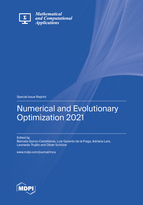Numerical and Evolutionary Optimization 2021
A special issue of Mathematical and Computational Applications (ISSN 2297-8747). This special issue belongs to the section "Engineering".
Deadline for manuscript submissions: closed (31 December 2021) | Viewed by 58324
Special Issue Editors
Interests: experimental algorithmics; metaheuristics; genetic algorithms; combinatorial optimization; machine learning; causal inference applications
Special Issues, Collections and Topics in MDPI journals
Interests: computer vision; optimization; metaheuristics
Special Issues, Collections and Topics in MDPI journals
Interests: multi-objective optimization; optimization; evolutionary computation; mathematical programming; memetic algorithms
Special Issues, Collections and Topics in MDPI journals
Interests: evolutionary computation; machine learning; data science; computer vision
Special Issues, Collections and Topics in MDPI journals
Interests: multi-objective optimization; evolutionary computation (genetic algorithms and evolution strategies); numerical analysis; engineering applications
Special Issues, Collections and Topics in MDPI journals
Special Issue Information
Dear Colleagues,
This Special Issue will mainly consist of selected papers presented at the 9th International Workshop on Numerical and Evolutionary Optimization (NEO 2021, see http://neo.cinvestav.mx for detailed information). However, other works that fit within the scope of the NEO are welcome. Papers considered to fit the scope of the journal and to be of sufficient quality after evaluation by the reviewers will be published free of charge.
The aim of this Special Issue is to collect papers on the intersection of numerical and evolutionary optimization. We strongly encourage the development of fast and reliable hybrid methods that maximize the strengths and minimize the weaknesses of each underlying paradigm while also being applicable to a broader class of problems. Moreover, this Special Issue aims to foster the understanding and adequate treatment of real-world problems, particularly in emerging fields that affect us all, such as healthcare, smart cities, and big data, among many others.
Topics of interest include (but are not limited to) the following:
A) Search and Optimization:
Single- and multi-objective optimization
Mathematical programming techniques
Evolutionary algorithms
Genetic programming
Hybrid and memetic algorithms
Set-oriented numerics
Stochastic optimization
Robust optimization
B) Real-World Problems:
Optimization, Machine Learning, and Metaheuristics applied to:
Energy production and consumption
Health monitoring systems
Computer vision and pattern recognition
Energy optimization and prediction
Modeling and control of real-world energy systems
Smart cities
Dr. Marcela Quiroz
Dr. Luis Gerardo de la Fraga
Dr. Adriana Lara
Dr. Leonardo Trujillo
Prof. Dr. Oliver Schütze
Guest Editors
Manuscript Submission Information
Manuscripts should be submitted online at www.mdpi.com by registering and logging in to this website. Once you are registered, click here to go to the submission form. Manuscripts can be submitted until the deadline. All papers will be peer-reviewed. Accepted papers will be published continuously in the journal (as soon as accepted) and will be listed together on the special issue website. Research articles, review articles as well as short communications are invited. For planned papers, a title and short abstract (about 100 words) can be sent to the Editorial Office for announcement on this website.
Submitted manuscripts should not have been published previously, nor be under consideration for publication elsewhere (except conference proceedings papers). All manuscripts are thoroughly refereed through a single-blind peer-review process. A guide for authors and other relevant information for submission of manuscripts is available on the Instructions for Authors page. Mathematical and Computational Applications is an international peer-reviewed open access quarterly journal published by MDPI.
Please visit the Instructions for Authors page before submitting a manuscript. Submitted papers should be well formatted and use good English. Authors may use MDPI's English editing service prior to publication or during author revisions.
Benefits of Publishing in a Special Issue
- Ease of navigation: Grouping papers by topic helps scholars navigate broad scope journals more efficiently.
- Greater discoverability: Special Issues support the reach and impact of scientific research. Articles in Special Issues are more discoverable and cited more frequently.
- Expansion of research network: Special Issues facilitate connections among authors, fostering scientific collaborations.
- External promotion: Articles in Special Issues are often promoted through the journal's social media, increasing their visibility.
- Reprint: MDPI Books provides the opportunity to republish successful Special Issues in book format, both online and in print.
Further information on MDPI's Special Issue policies can be found here.










